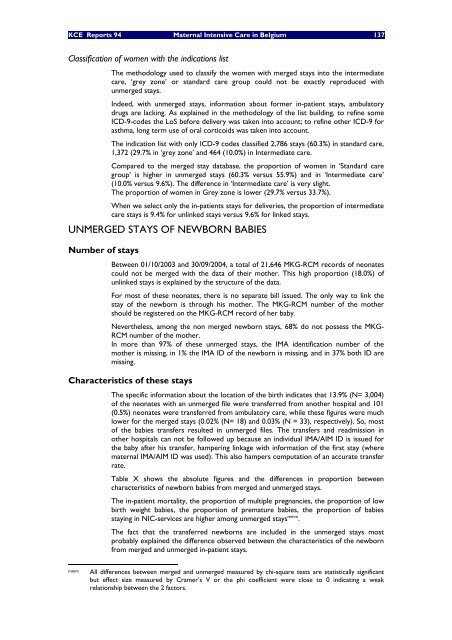Soins maternels intensifs (Maternal Intensive Care) en Belgique - KCE
Soins maternels intensifs (Maternal Intensive Care) en Belgique - KCE
Soins maternels intensifs (Maternal Intensive Care) en Belgique - KCE
Create successful ePaper yourself
Turn your PDF publications into a flip-book with our unique Google optimized e-Paper software.
<strong>KCE</strong> Reports 94 <strong>Maternal</strong> <strong>Int<strong>en</strong>sive</strong> <strong>Care</strong> in Belgium 137<br />
Classification of wom<strong>en</strong> with the indications list<br />
The methodology used to classify the wom<strong>en</strong> with merged stays into the intermediate<br />
care, ‘grey zone’ or standard care group could not be exactly reproduced with<br />
unmerged stays.<br />
Indeed, with unmerged stays, information about former in-pati<strong>en</strong>t stays, ambulatory<br />
drugs are lacking. As explained in the methodology of the list building, to refine some<br />
ICD-9-codes the LoS before delivery was tak<strong>en</strong> into account; to refine other ICD-9 for<br />
asthma, long term use of oral corticoids was tak<strong>en</strong> into account.<br />
The indication list with only ICD-9 codes classified 2,786 stays (60.3%) in standard care,<br />
1,372 (29.7% in ‘grey zone’ and 464 (10.0%) in Intermediate care.<br />
Compared to the merged stay database, the proportion of wom<strong>en</strong> in ‘Standard care<br />
group’ is higher in unmerged stays (60.3% versus 55.9%) and in ‘Intermediate care’<br />
(10.0% versus 9.6%). The differ<strong>en</strong>ce in ‘Intermediate care’ is very slight.<br />
The proportion of wom<strong>en</strong> in Grey zone is lower (29.7% versus 33.7%).<br />
Wh<strong>en</strong> we select only the in-pati<strong>en</strong>ts stays for deliveries, the proportion of intermediate<br />
care stays is 9.4% for unlinked stays versus 9.6% for linked stays.<br />
UNMERGED STAYS OF NEWBORN BABIES<br />
Number of stays<br />
Betwe<strong>en</strong> 01/10/2003 and 30/09/2004, a total of 21,646 MKG-RCM records of neonates<br />
could not be merged with the data of their mother. This high proportion (18.0%) of<br />
unlinked stays is explained by the structure of the data.<br />
For most of these neonates, there is no separate bill issued. The only way to link the<br />
stay of the newborn is through his mother. The MKG-RCM number of the mother<br />
should be registered on the MKG-RCM record of her baby.<br />
Nevertheless, among the non merged newborn stays, 68% do not possess the MKG-<br />
RCM number of the mother.<br />
In more than 97% of these unmerged stays, the IMA id<strong>en</strong>tification number of the<br />
mother is missing, in 1% the IMA ID of the newborn is missing, and in 37% both ID are<br />
missing.<br />
Characteristics of these stays<br />
The specific information about the location of the birth indicates that 13.9% (N= 3,004)<br />
of the neonates with an unmerged file were transferred from another hospital and 101<br />
(0.5%) neonates were transferred from ambulatory care, while these figures were much<br />
lower for the merged stays (0.02% (N= 18) and 0.03% (N = 33), respectively). So, most<br />
of the babies transfers resulted in unmerged files. The transfers and readmission in<br />
other hospitals can not be followed up because an individual IMA/AIM ID is issued for<br />
the baby after his transfer, hampering linkage with information of the first stay (where<br />
maternal IMA/AIM ID was used). This also hampers computation of an accurate transfer<br />
rate.<br />
Table X shows the absolute figures and the differ<strong>en</strong>ces in proportion betwe<strong>en</strong><br />
characteristics of newborn babies from merged and unmerged stays.<br />
The in-pati<strong>en</strong>t mortality, the proportion of multiple pregnancies, the proportion of low<br />
birth weight babies, the proportion of premature babies, the proportion of babies<br />
staying in NIC-services are higher among unmerged stays mmm .<br />
The fact that the transferred newborns are included in the unmerged stays most<br />
probably explained the differ<strong>en</strong>ce observed betwe<strong>en</strong> the characteristics of the newborn<br />
from merged and unmerged in-pati<strong>en</strong>t stays.<br />
mmm All differ<strong>en</strong>ces betwe<strong>en</strong> merged and unmerged measured by chi-square tests are statistically significant<br />
but effect size measured by Cramer’s V or the phi coeffici<strong>en</strong>t were close to 0 indicating a weak<br />
relationship betwe<strong>en</strong> the 2 factors.

















